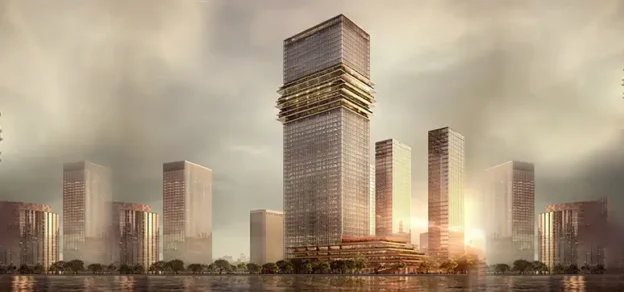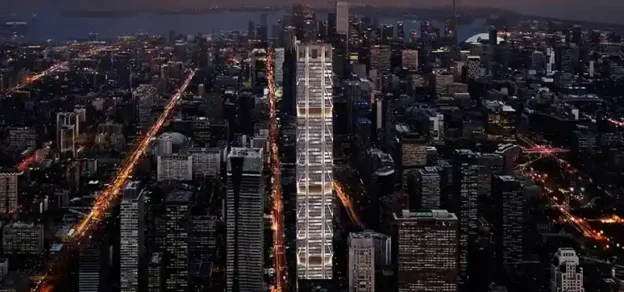The increasing attention to sustainability in the architecture and construction industry is leading to the development of innovative, high-performance solutions. To reduce emissions and embedded carbon, research efforts have been made to develop new materials and technologies for sustainable construction options. For the industry, it is indeed pivotal to mitigate energy requirements and emissions, but also to increase the well-being of occupants.
One relevant example in façade and interior design is represented by liquid crystal dynamic glazing. While the most common areas of use for liquid crystals are electronic displays in smartphones, personal computers and flat-panel TVs, switchable windows are a new area of application in architecture and construction. Dynamic glass alters its optical and thermal properties when voltage is applied and is rapidly gaining popularity as an easier alternative for blinds and curtains, with far less maintenance. Building designers are considering this technology for its ability to provide sustainable opportunities for insulation, solar control, energy performance and visual comfort.
After pioneering work for over 100 years, the market leader for liquid crystal Merck KGaA equipped the architecture and construction industry with an unprecedented standard by combining this technology with glass. eyrise®, a subsidiary of Merck based in The Netherlands, developed dynamic and switchable glazing for interiors and exteriors. This technology can block part of the light and heat, turning the glass into a dark state, or allowing more incoming light, leading to a bright state. This transition is possible in less than a second, creating instant shading and temperature regulation while preserving natural light and outside views in all situations.
The construction industry is acquainted with switchable glass based on electrochromic technology, but this material shows a slower switching speed and a blue glass appearance in the tinted state. On the opposite, dynamic glazing based on liquid crystal technology is instantaneous and colour neutral. When also compared to standard sun blinds or louvered systems, it additionally offers reduced maintenance and mechanical breakdown, thanks to an estimated lifetime of over 25 years. Liquid crystal dynamic glazing, therefore, represents a higher-performing alternative because of its differentiating materials and technological competitive advantage. But its contribution to sustainability does not stop there, being able to increase the score on various certification categories on multiple green standards.
Most of these certifications are based on the Sustainable Development Goals (SDG) of the United Nations, which are more than only ecological goals. A building needs to score points in three pillars: Society, Economy and Ecology. Programs such as the Building Research Establishment Environment Assessment Method (BREEAM) and Leadership in Energy and Environmental Design (LEED) have set a high bar in building performance. Achieving the highest rating delivers benefits on both a financial and environmental front, with tenants willing to commit to premium fees. In other cases, as for Estidama in the Middle East, they are initiatives and methodologies for building design. Nonetheless, their goal is to spread a sustainable mindset for environmental, economic, cultural and social value creation.
eyrise® liquid crystal glazing can increase the score on various certification categories of multiple green standards, with a contribution to the three pillars and to both embodied and operational emissions. To achieve the most abatement potential the building industry should indeed select materials wisely, not only for how much energy they help save, but also because of their reduced embodied carbon footprint. eyrise® has a reduced carbon footprint being produced with renewable wind power and minimised waste.
Operational carbon reduction is instead addressed through the thermal regulation properties of the glass that offer control over the amount of light and heat absorbed or dispersed, with buildings needing less air conditioning. More to the environmental impact, liquid crystal dynamic glass also shows significant implications for human-centred design. As it maximizes solar gain and ensures the best natural light conditions with no glare, eyrise® provides well-being and comfort to the end user. The color neutrality supports occupants’ natural circadian rhythms throughout the day, offering a more positive impact on health and wellbeing.
A versatile advanced material that helps the industry advance towards a sustainable ethos, dynamic liquid crystal glazing will contribute to creating a built environment that fits for purpose.
Case 1: BAFTA 195 PICCADILLY, LONDON, UK
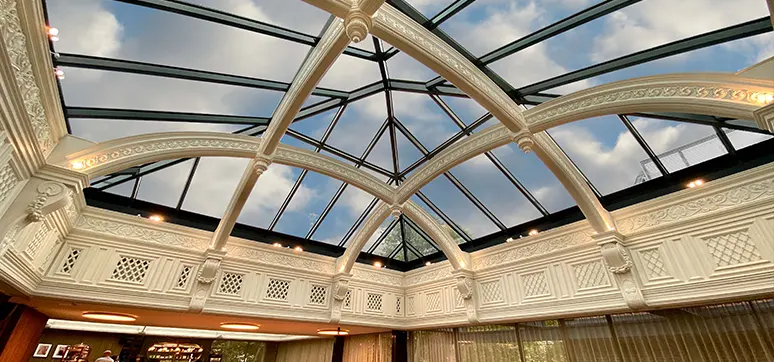
One example comes from what The British Academy of Film and Television Arts (BAFTA) achieved after its reopening to the public in 2022. Built-in 1883, the prestigious Victorian location at Piccadilly 195, London, has served as BAFTA’s headquarters since 1974. Its aim is to support and promote the next generation of performers and talented individuals helping them build careers in the creative industries.
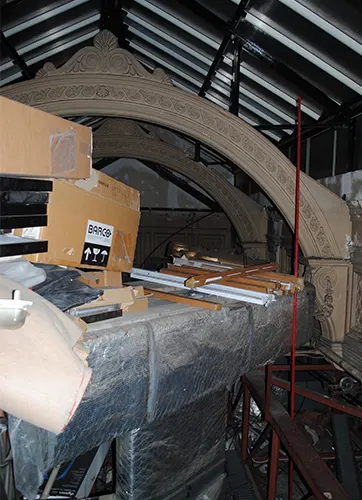 During the seven-year renovation, BAFTA wanted ideas to improve the building’s contribution to their wide charitable remit. The UK-based studio Benedetti Architects, who won the commission and was in charge of the redesign, had discovered forgotten structures and decorative plasterwork of two huge roof lights from the original 1883 building. These structures had been covered in 1976 when BAFTA moved in to create a theatre, a dark space for a 227-seat cinema.
During the seven-year renovation, BAFTA wanted ideas to improve the building’s contribution to their wide charitable remit. The UK-based studio Benedetti Architects, who won the commission and was in charge of the redesign, had discovered forgotten structures and decorative plasterwork of two huge roof lights from the original 1883 building. These structures had been covered in 1976 when BAFTA moved in to create a theatre, a dark space for a 227-seat cinema.
Benedetti proposed to create an additional new floor, that would generate the extra area BAFTA needed while preserving the existing theatre. The orientation given, and glazing ratios became crucial to the design. However, a fully glazed floor turned out not to be ideal for a members’ bar or multi-purpose restaurant area in the additional floor. Crucially, removing up to 80% of heat and glare necessary for the new top floor to function, the eyrise® liquid crystal glazing system proved the right solution. To glaze the rooftop, 82 dynamic liquid crystal windows were installed, of varying shapes and sizes. By raising the roof and re-integrating the roof lights with such innovative technology, the facility has been enriched with a bright new space doubling the building’s capacity. This increase in floor space enables BAFTA to expand its cultural offer, with a greater variety of initiatives and activities.
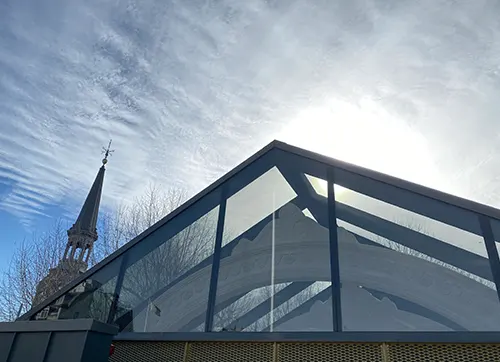
The most visible and immediate impact of dynamic glazing on the building was however to provide instant solar shading without compromising natural daylight. Remaining uniquely clear, the glass allows users to view the extraordinary St. James’s churchyard tree canopy, now embraced in the view from the 4th floor.
The windows increase the well-being of the occupants through visual comfort, thermal regulation and color neutrality, while also helping to reduce energy consumption. Despite the dramatic increase in glass used, the renovation has indeed paid back in terms of energy efficiency. “At the start of the project, our Victorian heritage building had old technology and original features which leaked heat, giving us a high EPC rating. Putting in a fully glazed roof was a challenge if we wanted to concentrate on sustainability,” said Pauline Campbell, BAFTA’s Head of Property. “The new roof light structures developed by eyrise® can automatically adjust the shading of the glazing to reduce solar gain, resulting in a lower cooling requirement.
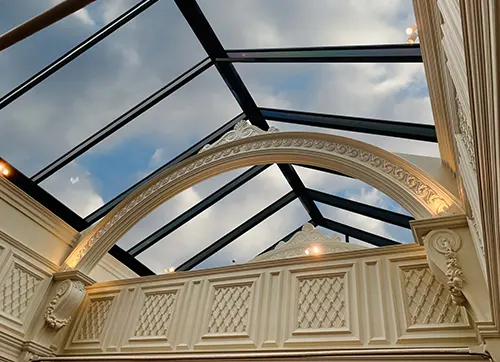 This is controlled so that the solar gain can be limited when not needed but can also be actively allowed to heat the space when heating is required. Working the eyrise® glazing into our project ensured BAFTA’s certification has been upgraded from a G (the least efficient rating) to a UK EPC rating of 48, which corresponds to a B and is compared to a new build, something that would never have been possible without the technology.” While traditional glazing has historically lowered a building’s energy efficiency, implementing the latest developments in glass technology has helped BAFTA reduce its ecological footprint and create a sustainable centre of excellence.
This is controlled so that the solar gain can be limited when not needed but can also be actively allowed to heat the space when heating is required. Working the eyrise® glazing into our project ensured BAFTA’s certification has been upgraded from a G (the least efficient rating) to a UK EPC rating of 48, which corresponds to a B and is compared to a new build, something that would never have been possible without the technology.” While traditional glazing has historically lowered a building’s energy efficiency, implementing the latest developments in glass technology has helped BAFTA reduce its ecological footprint and create a sustainable centre of excellence.
PROJECT NAME: British Academy of Film & Television Arts (BAFTA) Headquarters
LOCATION: 195 Piccadilly, London UK
CLIENT: British Academy of Film & Television Arts (BAFTA)
ARCHITECT: Benedetti Architects, London
OTHER CONSULTANTS: Façade Contractor – IPIG Ltd., Main contractor – Knight Harwood
Materials used for façade & fenestration: eyrise® s350 Instant Solar Shading Glass
Case 2: CAMPUS GERMANY AT EXPO 2020 DUBAI, UAE

The contribution of advanced building materials to sustainability is particularly pivotal in geographies facing specific climate conditions. In the Middle East, for instance, solar protection is not a luxury. It can contribute to creating a comfortable light and temperature environment while reducing the need for air conditioning energy.
In line with the imperative of undertaking a sustainable path towards a future where the environment and communities are protected and preserved, Expo 2020 Dubai, made “Connecting Minds, Creating the Future” its central theme. Within the exhibition space, the Sustainability district showcased the world’s most advanced scientific, technological, economic and social progress from over 190 countries, each with a national pavilion.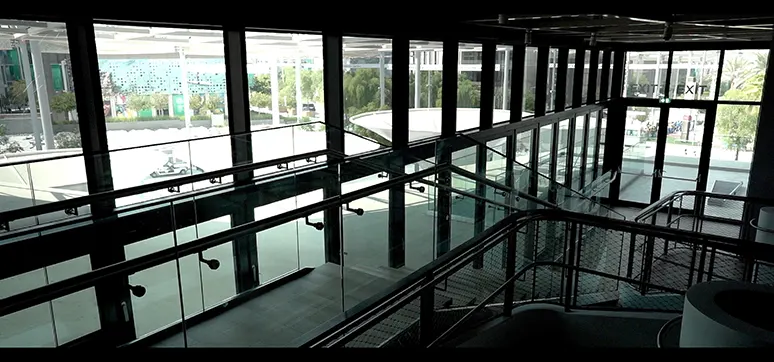
Designed by Berlin-based architects LAVA, Campus Germany was the German representation aligning with the Expo’s central theme and built around the principles of the Sustainability district, where it was positioned. The structure is an interactive display of creative sustainable solutions alongside new innovations. The architecture is an ensemble of suspended cubes and steel poles covered by a floating roof and shelled with liquid crystal glass elements. The hybrid façade creates a dynamic effect where every material is sustainable and designed to respond to the different weather conditions during the six-month Expo period.
“The German Pavilion puts an important spotlight on one of the key issues of our time,” said Céline Glipa, CEO at Eyrise® B.V. “Our instant solar shading glass contributes to this focus on sustainability by creating a comfortable environment for visitors to the exhibition while supporting the building’s energy efficiency ambitions.” Campus Germany’s approach was indeed bottom-up and human-centred. The purpose of the building was to achieve visitors’ comfort and ease the interaction between people and physical space.
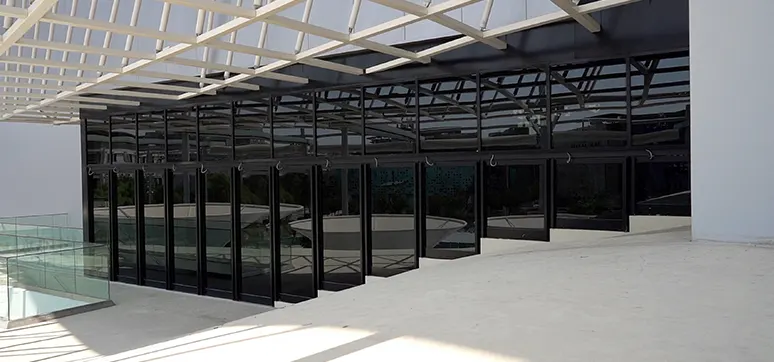
The design principles indeed focused on having a structure that could adapt and change. Even after sunset, when the Expo was still open, the architects wanted to create mystery around the inside of the pavilion. A dynamic façade perfectly contributed to the scope, being capable to switch between unveiling and hiding light coming from the inside of the building. This way, the German Pavilion provided visitors with a true spatial experience, where functionality, structure and technology blended harmonically.
PROJECT NAME: Campus Germany
LOCATION: World Expo 2020 Dubai, UAE
CLIENT: German Federal Ministry for Economic Affairs and Energy
ARCHITECT: Lava Architects, Berlin
OTHER CONSULTANTS: Future Architectural Glass LLC, Ras Al Khaimah, UAE, ARGE Deutscher Pavilion EXPO 2020 Dubai GbR
MATERIALS USED FOR FAÇADE & FENESTRATION: eyrise® s350 Instant Solar Shading Glass
COMPLETION DATE: September 2021








